Theresa Eimer
Revisiting Learning Rate Control
Jul 02, 2025Abstract:The learning rate is one of the most important hyperparameters in deep learning, and how to control it is an active area within both AutoML and deep learning research. Approaches for learning rate control span from classic optimization to online scheduling based on gradient statistics. This paper compares paradigms to assess the current state of learning rate control. We find that methods from multi-fidelity hyperparameter optimization, fixed-hyperparameter schedules, and hyperparameter-free learning often perform very well on selected deep learning tasks but are not reliable across settings. This highlights the need for algorithm selection methods in learning rate control, which have been neglected so far by both the AutoML and deep learning communities. We also observe a trend of hyperparameter optimization approaches becoming less effective as models and tasks grow in complexity, even when combined with multi-fidelity approaches for more expensive model trainings. A focus on more relevant test tasks and new promising directions like finetunable methods and meta-learning will enable the AutoML community to significantly strengthen its impact on this crucial factor in deep learning.
Growing with Experience: Growing Neural Networks in Deep Reinforcement Learning
Jun 13, 2025Abstract:While increasingly large models have revolutionized much of the machine learning landscape, training even mid-sized networks for Reinforcement Learning (RL) is still proving to be a struggle. This, however, severely limits the complexity of policies we are able to learn. To enable increased network capacity while maintaining network trainability, we propose GrowNN, a simple yet effective method that utilizes progressive network growth during training. We start training a small network to learn an initial policy. Then we add layers without changing the encoded function. Subsequent updates can utilize the added layers to learn a more expressive policy, adding capacity as the policy's complexity increases. GrowNN can be seamlessly integrated into most existing RL agents. Our experiments on MiniHack and Mujoco show improved agent performance, with incrementally GrowNN-deeper networks outperforming their respective static counterparts of the same size by up to 48% on MiniHack Room and 72% on Ant.
Task Scheduling & Forgetting in Multi-Task Reinforcement Learning
Mar 03, 2025Abstract:Reinforcement learning (RL) agents can forget tasks they have previously been trained on. There is a rich body of work on such forgetting effects in humans. Therefore we look for commonalities in the forgetting behavior of humans and RL agents across tasks and test the viability of forgetting prevention measures from learning theory in RL. We find that in many cases, RL agents exhibit forgetting curves similar to those of humans. Methods like Leitner or SuperMemo have been shown to be effective at counteracting human forgetting, but we demonstrate they do not transfer as well to RL. We identify a likely cause: asymmetrical learning and retention patterns between tasks that cannot be captured by retention-based or performance-based curriculum strategies.
ARLBench: Flexible and Efficient Benchmarking for Hyperparameter Optimization in Reinforcement Learning
Sep 27, 2024


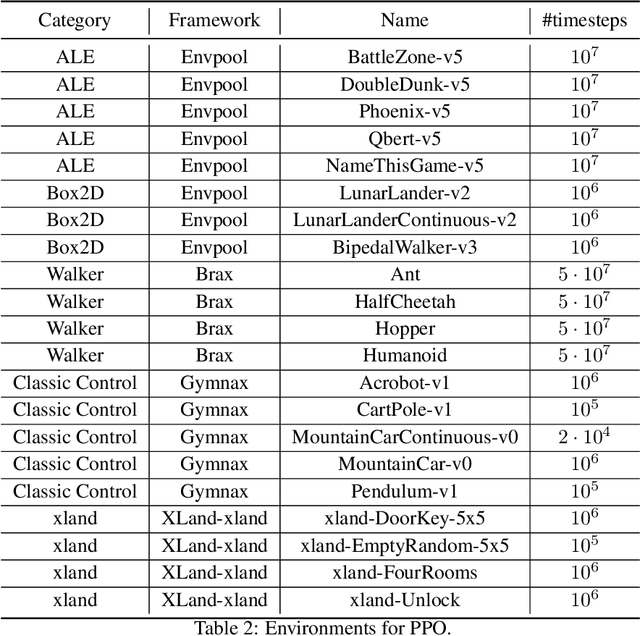
Abstract:Hyperparameters are a critical factor in reliably training well-performing reinforcement learning (RL) agents. Unfortunately, developing and evaluating automated approaches for tuning such hyperparameters is both costly and time-consuming. As a result, such approaches are often only evaluated on a single domain or algorithm, making comparisons difficult and limiting insights into their generalizability. We propose ARLBench, a benchmark for hyperparameter optimization (HPO) in RL that allows comparisons of diverse HPO approaches while being highly efficient in evaluation. To enable research into HPO in RL, even in settings with low compute resources, we select a representative subset of HPO tasks spanning a variety of algorithm and environment combinations. This selection allows for generating a performance profile of an automated RL (AutoRL) method using only a fraction of the compute previously necessary, enabling a broader range of researchers to work on HPO in RL. With the extensive and large-scale dataset on hyperparameter landscapes that our selection is based on, ARLBench is an efficient, flexible, and future-oriented foundation for research on AutoRL. Both the benchmark and the dataset are available at https://github.com/automl/arlbench.
* Accepted at the 17th European Workshop on Reinforcement Learning
AutoML in the Age of Large Language Models: Current Challenges, Future Opportunities and Risks
Jun 13, 2023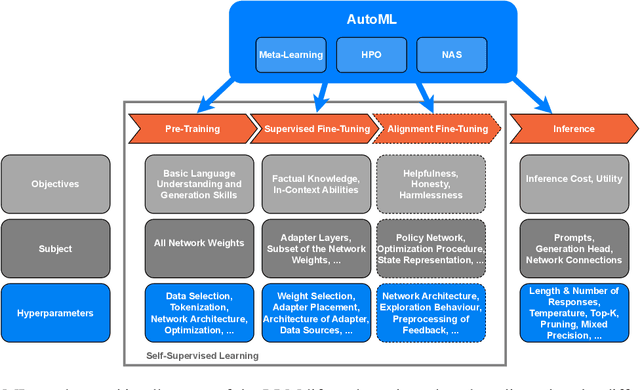

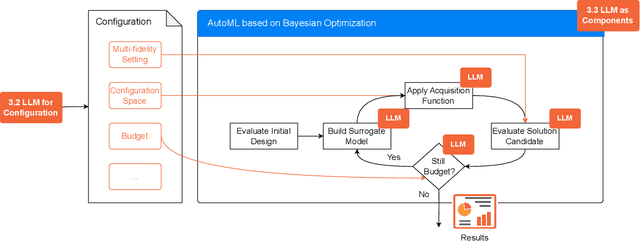
Abstract:The fields of both Natural Language Processing (NLP) and Automated Machine Learning (AutoML) have achieved remarkable results over the past years. In NLP, especially Large Language Models (LLMs) have experienced a rapid series of breakthroughs very recently. We envision that the two fields can radically push the boundaries of each other through tight integration. To showcase this vision, we explore the potential of a symbiotic relationship between AutoML and LLMs, shedding light on how they can benefit each other. In particular, we investigate both the opportunities to enhance AutoML approaches with LLMs from different perspectives and the challenges of leveraging AutoML to further improve LLMs. To this end, we survey existing work, and we critically assess risks. We strongly believe that the integration of the two fields has the potential to disrupt both fields, NLP and AutoML. By highlighting conceivable synergies, but also risks, we aim to foster further exploration at the intersection of AutoML and LLMs.
Hyperparameters in Reinforcement Learning and How To Tune Them
Jun 02, 2023Abstract:In order to improve reproducibility, deep reinforcement learning (RL) has been adopting better scientific practices such as standardized evaluation metrics and reporting. However, the process of hyperparameter optimization still varies widely across papers, which makes it challenging to compare RL algorithms fairly. In this paper, we show that hyperparameter choices in RL can significantly affect the agent's final performance and sample efficiency, and that the hyperparameter landscape can strongly depend on the tuning seed which may lead to overfitting. We therefore propose adopting established best practices from AutoML, such as the separation of tuning and testing seeds, as well as principled hyperparameter optimization (HPO) across a broad search space. We support this by comparing multiple state-of-the-art HPO tools on a range of RL algorithms and environments to their hand-tuned counterparts, demonstrating that HPO approaches often have higher performance and lower compute overhead. As a result of our findings, we recommend a set of best practices for the RL community, which should result in stronger empirical results with fewer computational costs, better reproducibility, and thus faster progress. In order to encourage the adoption of these practices, we provide plug-and-play implementations of the tuning algorithms used in this paper at https://github.com/facebookresearch/how-to-autorl.
Hyperparameters in Contextual RL are Highly Situational
Dec 21, 2022Abstract:Although Reinforcement Learning (RL) has shown impressive results in games and simulation, real-world application of RL suffers from its instability under changing environment conditions and hyperparameters. We give a first impression of the extent of this instability by showing that the hyperparameters found by automatic hyperparameter optimization (HPO) methods are not only dependent on the problem at hand, but even on how well the state describes the environment dynamics. Specifically, we show that agents in contextual RL require different hyperparameters if they are shown how environmental factors change. In addition, finding adequate hyperparameter configurations is not equally easy for both settings, further highlighting the need for research into how hyperparameters influence learning and generalization in RL.
Automated Dynamic Algorithm Configuration
May 27, 2022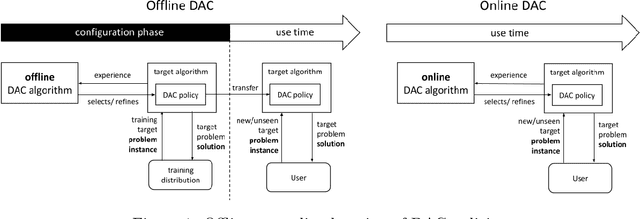

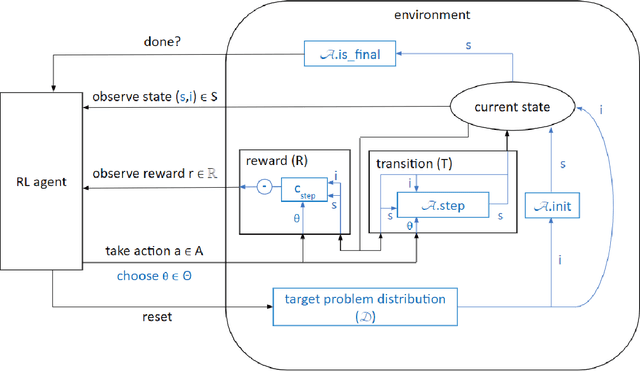

Abstract:The performance of an algorithm often critically depends on its parameter configuration. While a variety of automated algorithm configuration methods have been proposed to relieve users from the tedious and error-prone task of manually tuning parameters, there is still a lot of untapped potential as the learned configuration is static, i.e., parameter settings remain fixed throughout the run. However, it has been shown that some algorithm parameters are best adjusted dynamically during execution, e.g., to adapt to the current part of the optimization landscape. Thus far, this is most commonly achieved through hand-crafted heuristics. A promising recent alternative is to automatically learn such dynamic parameter adaptation policies from data. In this article, we give the first comprehensive account of this new field of automated dynamic algorithm configuration (DAC), present a series of recent advances, and provide a solid foundation for future research in this field. Specifically, we (i) situate DAC in the broader historical context of AI research; (ii) formalize DAC as a computational problem; (iii) identify the methods used in prior-art to tackle this problem; (iv) conduct empirical case studies for using DAC in evolutionary optimization, AI planning, and machine learning.
Contextualize Me -- The Case for Context in Reinforcement Learning
Feb 09, 2022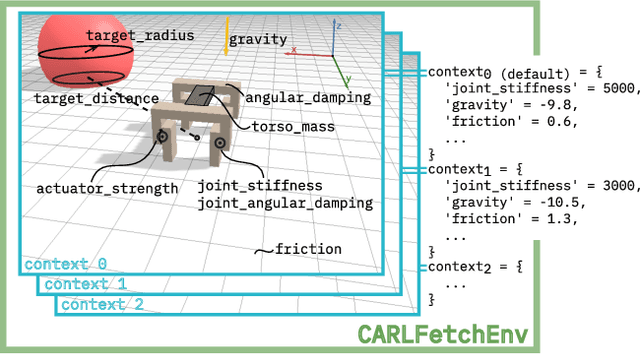
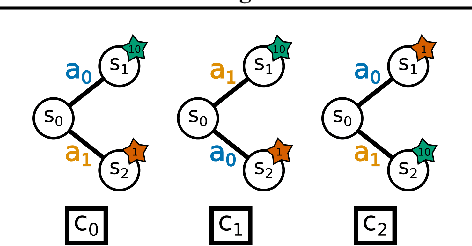
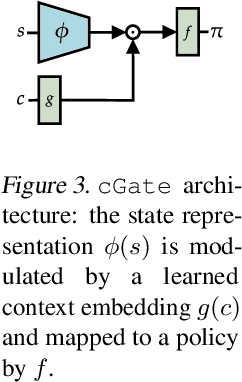
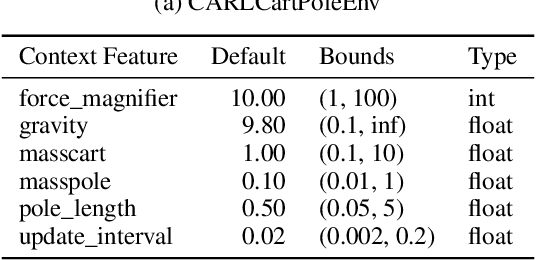
Abstract:While Reinforcement Learning (RL) has made great strides towards solving increasingly complicated problems, many algorithms are still brittle to even slight changes in environments. Contextual Reinforcement Learning (cRL) provides a theoretical framework to model such changes in a principled manner, thereby enabling flexible, precise and interpretable task specification and generation. Thus, cRL is an important formalization for studying generalization in RL. In this work, we reason about solving cRL in theory and practice. We show that theoretically optimal behavior in contextual Markov Decision Processes requires explicit context information. In addition, we empirically explore context-based task generation, utilizing context information in training and propose cGate, our state-modulating policy architecture. To this end, we introduce the first benchmark library designed for generalization based on cRL extensions of popular benchmarks, CARL. In short: Context matters!
Automated Reinforcement Learning (AutoRL): A Survey and Open Problems
Jan 11, 2022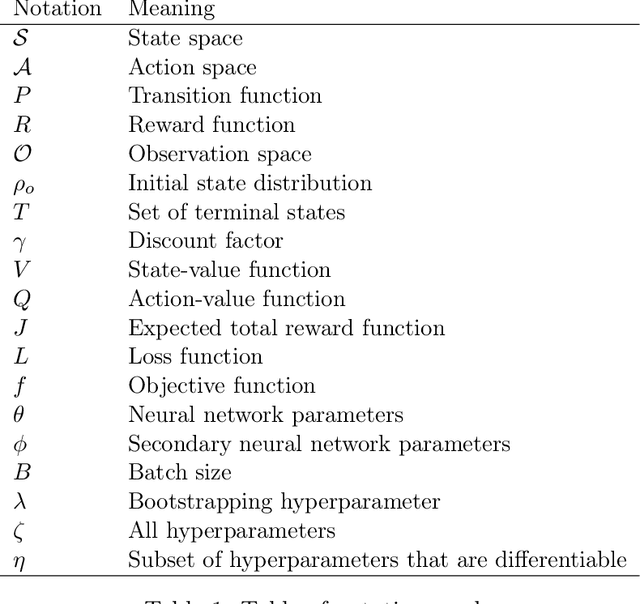
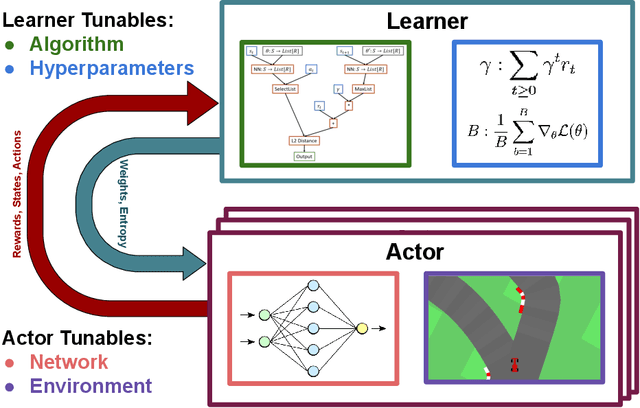


Abstract:The combination of Reinforcement Learning (RL) with deep learning has led to a series of impressive feats, with many believing (deep) RL provides a path towards generally capable agents. However, the success of RL agents is often highly sensitive to design choices in the training process, which may require tedious and error-prone manual tuning. This makes it challenging to use RL for new problems, while also limits its full potential. In many other areas of machine learning, AutoML has shown it is possible to automate such design choices and has also yielded promising initial results when applied to RL. However, Automated Reinforcement Learning (AutoRL) involves not only standard applications of AutoML but also includes additional challenges unique to RL, that naturally produce a different set of methods. As such, AutoRL has been emerging as an important area of research in RL, providing promise in a variety of applications from RNA design to playing games such as Go. Given the diversity of methods and environments considered in RL, much of the research has been conducted in distinct subfields, ranging from meta-learning to evolution. In this survey we seek to unify the field of AutoRL, we provide a common taxonomy, discuss each area in detail and pose open problems which would be of interest to researchers going forward.
 Add to Chrome
Add to Chrome Add to Firefox
Add to Firefox Add to Edge
Add to Edge